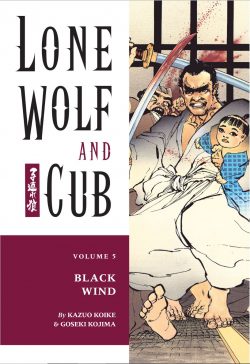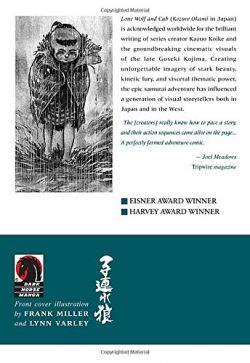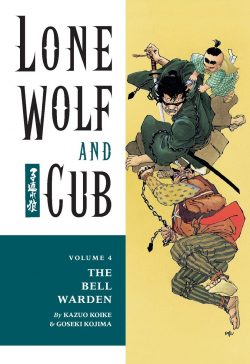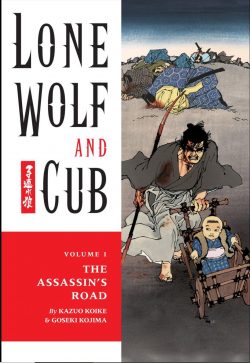

By Kazuo Koike & Goseki Kojima, translated by Dana Lewis (Dark Horse Manga)
ISBN: 978-1-56971-506-8 (TPB/digital edition)
Best known in the West as Lone Wolf and Cub, the vast Samurai saga created by Kazuo Koike & Goseki Kojima is without doubt a global classic of comics literature. An example of the popular Chanbara or “sword-fighting” genre of print and screen, Kozure Okami was first serialised in Weekly Manga Action from September 1970 until April 1976. It was an immense and overwhelming Seinen (“Men’s manga”) hit…
The tales prompted thematic companion series Kubikiri Asa (Samurai Executioner) which ran from 1972-1976, but the major draw – at home and, increasingly, abroad – was always the nomadic wanderings of doomed noble Ōgami Ittō and his solemn, silent child.
Revered and influential, Kozure Okami was followed after years of supplication by fans and editors by sequel Shin Lone Wolf & Cub (illustrated by Hideki Mori) and even spawned – through Koike’s indirect participation – science fiction homage Lone Wolf 2100 by Mike Kennedy & Francisco Ruiz Velasco…
The original saga has been successfully adapted to most other media, spawning movies, plays, TV series (plural), games and merchandise. The property is infamously still in Hollywood pre-production…
The several thousand pages of enthralling, exotic, intoxicating narrative art produced by these legendary creators eventually filled 28 collected volumes, beguiling generations of readers in Japan and, inevitably, the world. More importantly, their philosophically nihilistic odyssey – with its timeless themes and iconic visuals – has influenced hordes of other creators. The many manga, comics and movies these stories have inspired around the globe are impossible to count. Frank Miller, who illustrated the cover of this edition, referenced the series in Daredevil, his dystopian opus Ronin, The Dark Knight Returns and Sin City. Max Allan Collins’ Road to Perdition is a proudly unashamed tribute to the masterpiece of vengeance-fiction.
Stan Sakai has superbly spoofed, pastiched and celebrated the wanderer’s path in his own epic Usagi Yojimbo, and even children’s cartoon shows such as Samurai Jack are direct descendants of this astounding achievement of graphic narrative. The material has become part of a shared world culture.
In the West, we first saw the translated tales in 1987, as 45 Prestige Format editions from First Comics. That innovative trailblazer foundered before getting even a third of the way through the vast canon, after which Dark Horse Comics acquired the rights, systematically reprinting and translating the entire epic into 28 tankōbon-style editions of around 300 pages each. Once the entire epic was translated – between September 2000-December 2002 – it was all placed online through the Dark Horse Digital project.
Following cautionary warning ‘A Note to Readers’ – on stylistic interpretation – this moodily morbid monochrome collection truly gets underway, keeping many terms and concepts western readers may find unfamiliar. Therefore this edition offers at the close a Glossary providing detailed context on the term used in the stories…
Set in the era of the Tokugawa Shogunate, the saga concerns a foredoomed wandering killer who was once the Shōgun’s official executioner the Kōgi Kaishakunin: capable of cleaving a man in half with one stroke. An eminent individual of esteemed imperial standing, elevated social position and impeccable honour, Ōgami Ittō lost it all and now roams feudal Japan as a doomed soul hellbent for the dire, demon-haunted underworld of Meifumadō.
When the noble’s wife was murdered and his clan dishonoured thanks to the machinations of the treacherous, politically ambitious Yagyū Clan, the Emperor ordered Ogami to commit suicide. Instead he rebelled, choosing to be a despised Ronin (masterless samurai) assassin, pledged to revenge himself until all his betrayers were dead …or Hell claimed him.
His 3-year-old son, Daigorō, also chose the path of destruction and thus they together tread across the grimly evocative landscapes of Japan, one step ahead of doom, with death behind and before them…
Unflinching formula informs early episodes: the acceptance of a commission to kill an impossible target necessitates forging a cunning plan where relentless determination leads to inevitable success. Throughout each episode plot is underscored with bleak philosophical musings alternately informed by Buddhist teachings in conjunction with or in opposition to the unflinching personal honour code of Bushido…
That tactic is eschewed for a simple commission in opening tale ‘Trail Markers’ as Yagyū leaders plot how to remove the wanderer without incurring the severe penalties built into the social caste system. The disgraced ronin is protected by his own lowly status and a promise of truce unless he returns to Edo but has still found ways to frustrate clan ambitions. The situation has already cost dozens of proud warriors who foolishly sought out the Lone Wolf. And now the Emperor wants to investigate Yagyū activities…
With pressure mounting, schemers Yagyū-Sama and Ozunu agree to orchestrate a duel between Ōgami and infallible swordsman Yagyū Gunbei-Sama…
Using the wolf’s own complex graphic signalling system, the ploy unfolds, luring the assassin to a certain shrine where instead of another commission, he meets the man he supposedly cannot defeat: the one who should have been the Shōgun’s executioner in his stead.
Now as they face off, Gunbei relives the haughty error that cost him the exalted position of Kōgi Kaishakunin and learns to his eternal but brief regret that whilst he might be as good as he ever was, his opponent has grown even better. Moreover, Yagyū spies watching also take note and make more plans…
At this time bounty hunting was commonplace and ‘Executioner’s Hill’ sees the terrifying but currently unemployed Zodiac Gang use their deserved notoriety to terrorise a village whilst looking for fresh prey. Tragically for them, they recognise the “wolf with baby carriage” and overconfidently assume numerical advantage, a strategic geographical position, their own skills and Daigorō as a hostage will be sufficient to bag the biggest prize of their lives…
They were wrong.
When not expediting commissions the father and son vanished into the unnoticed common population invisible to the nobility. A moment of peace and therapeutically hard but honest work is abruptly curtailed when – whilst toiling to plant rice in paddies beside simple but happy villagers – the able-bodied stranger is pressganged by the local lord to build levees in advance of an expected flood…
Like a ‘Black Wind’ (one unexpected and out of season) the act has unforeseen consequences as the aristocrats – incensed by a highborn man demeaning himself (and all nobles) by digging in the dirt beside commoners – deploy warriors to avenge the shameful act and instead fall like harvested crops…
Every role in Japanese society was strictly proscribed and formalised. Certain executed persons were suitable candidates for O-Tomeshi when headless corpses would be used to test and sanctify swords. The swordsmen capable of holding the post were reputed to be as proficient with the sword as the Kōgi Kaishakunin…
As the investigation of the Yagyū’s role in Ōgami Ittō’s disgrace proceeds, the honourable Yamada Asaemon is ordered by shogunate Wakadoshiryori officials to look into the affair. However, ‘Decapitator Asaemon’ is disquieted by the final codicil of his mission: whatever the truth, the shameful behaviour of the Lone Wolf must end with his death…
The court is alive with intrigue and even before he has found his target, Yamada Asaemon is being hunted by Ura-Yagyū assassins…
Their sinister trap catches only one man of honour…
This medieval masterpiece closes with another convoluted tale of duty sullied as ‘The Guns of Sakai’ finds Inoue Geki – commander of Ōsaka castle’s rifle detachment – covertly hiring the nomadic assassin to kill one of the gunsmiths in his employ after discovering Shichirōbei has been making firearms for the rival Western Han.
The job is no simple affair. Somehow the well-set and protected traitor has exposed every spy set on his trail and the dutiful commander is desperate. He’s also not being completely straight with the Lone Wolf, but Ōgami is well aware of the fact and has a plan and ulterior aim of his own: possession of the experimental supergun he knows the master smith and his acolytes have perfected…
Set in a fiercely uncompromising world of tyranny, intrigue, privilege and misogyny, these episodes are unflinching and explicit in their treatment of violence – especially sexual violence – although this collection has the dubious distinction of being rape-free. Still plenty of slaughter though, and an astounding body-count…
Whichever English transliteration you prefer – Wolf and Baby Carriage is what I was first introduced to – Kazuo Koike & Goseki Kojima’s grandiose, thought-provoking, hell-bent Samurai tragedy is one of those too-rare breakthrough classics of global comics literature. A breathtaking tour de force, these are comics you must not miss.
Art & story © 1995, 2001 Kazuo Koike & Goseki Kojima. Cover art © 2001 Frank Miller. All other material © 2001 Dark Horse Comics, Inc. All rights reserved.




